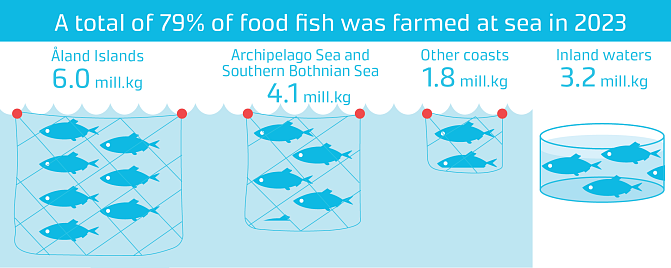Production of food fish decreased in 2023
In 2023, fish farmers produced 15.2 million kilos of fish for sale for human consumption. This was down by a million kilos from the previous year but at the same level as in the last ten years. At EUR 93 million, the production value decreased by roughly EUR 9 million from the year before. This is indicated by the aquaculture statistics of the Natural Resources Institute Finland (Luke).
Of the farmed food fish, rainbow trout accounted for 95 per cent (14.4 million kilos) and European whitefish for four per cent, while the remaining portion consisted of Arctic char, trout and sturgeon. A total of 0.4 million kilograms of roe was produced, amounting to more than EUR 7 million in value.
Food fish from farms in the sea area
Nearly 80 per cent of all fish for human consumption was produced in cages in the sea area. The Åland Islands accounted for half of total production in the sea area at almost six million kilos. In the coastal areas of Mainland Finland, production concentrated in the Archipelago Sea and the southern parts of the Bothnian Sea. In inland waters, over three million kilos of fish for human consumption were produced in onshore farms and tanks, as well as in recirculating aquaculture systems.

Fish fry from inland waters for stocking and food fish production
Mainly taking place in inland waters, fish fry production is an integral part of aquaculture. Fish fry are produced for food fish production and stocking into natural waterbodies to strengthen fish populations and support fishing. In 2023, fish farmers produced roughly 43 million fish fry in natural food ponds and other fry enterprises. Almost 26 million fish fry were delivered for stocking into waterbodies, of which 18 million were European whitefish, four million were pikeperch, and two million were salmon and trout each. In addition to these species, Arctic char, grayling and rainbow trout fry were produced for stocking.
Of the 17 million fish fry produced for food fish production, 15.4 million were rainbow trout and 1.4 million European whitefish. The number of rainbow trout fry decreased by two million and that of European whitefish fry by nearly one million from the previous year.
“The volume of fry production has nearly halved in the 2000s. This can be explained by a decrease in fish stocking and changes in stocking policies, a decrease in the number of fry producers, and the strengthening of natural fish populations of certain species, including pikeperch. Fish diseases such as saprolegnia as well as disturbance caused by seals and cormorants may have affected food fish production,” says Senior Statistician Pirkko Söderkultalahti.
Fish fry production decreased in natural nutrition ponds
Last year, 217 fish production enterprises operated in 352 fish farms. They have been divided into food fish enterprises, fry enterprises and natural food ponds farmers based on their production line. The number of food fish enterprises and natural food ponds farmers has decreased by a third during the last ten years. In 2023, there were 67 food fish companies and 126 natural food ponds farmers. The number of fry producers has remained close to 60, being 64 last year. A single company may have produced both food fish and fry.
Aquaculture statistics are published annually based on a survey sent to fish farms at the beginning of each year. Nearly all fish farms respond to the survey.



